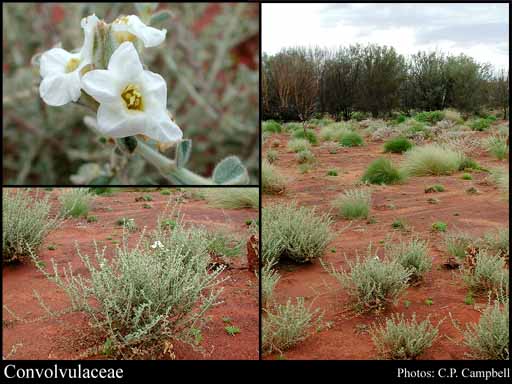- Reference
- Gen.Pl. [Jussieu] 132 (1789)
- Name Status
- Current

Scientific Description
Common name. Morning Glory Family.
Habit and leaf form. Herbs (a few), or herbaceous climbers (mostly, or trailing), or shrubs, or lianas, or trees (a few); laticiferous (usually), or non-laticiferous and without coloured juice. Autotrophic. Plants with neither basal nor terminal concentrations of leaves. Trailing or climbing (nearly always), or self supporting; stem twiners (characteristically), or scrambling. Convolvulus, Ipomoea, Rivea twining anticlockwise. Helophytic, mesophytic, and xerophytic. Leaves alternate; spiral; petiolate; non-sheathing; simple. Leaf blades dissected, or entire (entire or lobed); when dissected, pinnatifid, or palmately lobed; pinnately veined, or palmately veined; cross-venulate; cordate, or hastate, or sagittate. Leaves without stipules; without a persistent basal meristem. Stem anatomy. Nodes unilacunar. Secondary thickening anomalous (often), or developing from a conventional cambial ring; via concentric cambia (commonly), or from a single cambial ring.
Reproductive type, pollination. Fertile flowers hermaphrodite (usually), or functionally male, or functionally female. Unisexual flowers present, or absent. Plants hermaphrodite (usually), or dioecious (Hildebrandtia).
Inflorescence and flower features. Flowers solitary, or aggregated in ‘inflorescences’; in cymes. The terminal inflorescence unit cymose. Inflorescences nearly always simple or compound dichasia, or a cincinnus; with involucral bracts (often), or without involucral bracts. Flowers bracteate; bracteolate; medium-sized, or large; regular to somewhat irregular. The floral asymmetry (when noticeable) involving the perianth (K only). Flowers usually 5 merous; cyclic; tetracyclic. Free hypanthium absent. Hypogynous disk present; annular. Perianth with distinct calyx and corolla; 10; 2 -whorled; isomerous. Calyx 5; 1 -whorled; polysepalous, or gamosepalous (rarely); imbricate; persistent; with the median member posterior. Corolla 5; 1 -whorled; gamopetalous; valvate and plicate, or contorted and plicate; tubular (mostly, more or less), or campanulate, or urceolate; nearly always regular. Fertile stamens present, or absent (female Hildebrandtia). Androecium 5. Androecial members adnate (to the base of the corolla); all equal, or markedly unequal (often); free of one another; 1 -whorled. Androecium exclusively of fertile stamens. Stamens 5; oppositisepalous. Anthers dehiscing via longitudinal slits; introrse; tetrasporangiate. Fertile gynoecium present, or absent (male Hildebrandtia). Gynoecium 2(–5) carpelled. The pistil (1–)2(–5) celled. Gynoecium syncarpous (at least, almost, when synstylous); synovarious to eu-syncarpous, or synstylous (carpels the joined only by the common style); superior. Ovary unilocular, or plurilocular; (1–)2(–5) locular. Gynoecium median. Styles 1–5; free to partially joined; apical, or ‘gynobasic’. Stigmas dry type; papillate; Group II type. Placentation basal. Ovules 2 per locule; ascending; apotropous; non-arillate; anatropous.
Fruit and seed features. Fruit fleshy, or non-fleshy. The fruiting carpel when synstylous dehiscent, or indehiscent; nucular, or baccate. Fruit dehiscent, or indehiscent; a capsule, or a berry, or a nut. Capsules loculicidal, or circumscissile, or splitting irregularly. Seeds endospermic. Endosperm oily. Seeds conspicuously hairy, or not conspicuously hairy. Cotyledons 2 (plicate, often bifid). Embryo chlorophyllous (5/11); straight, or curved. Seedling. Germination phanerocotylar.
Physiology, biochemistry. Aluminium accumulation not found. Photosynthetic pathway: C3.
Geography, cytology, number of species. World distribution: cosmopolitan. X = 7–15(+). 1650 species.
Keys
Western Australian Genera and Families of Flowering Plants — an interactive key
T.D. Macfarlane, L. Watson, N.G. Marchant